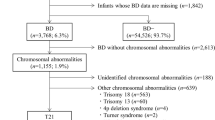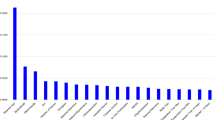Summary
Birth weight among 12,392 twin pairs were analysed in relation to survival state, sex and zygosity. Mean birth weights were higher in live birth than in stillbirth twins, and among the former the heaviest mean birth weight was seen in first-born males followed by second-born males, first-born females and second-born females in this order. Coefficient of variation was smaller in live birth than in stillbirth twins. Distribution of weight was negatively skewed in live birth twins, whereas it was positively skewed in stillbirth twins. Frequency of low-birth-weight (LBW) was higher in stillbirth than in live birth twins. It was indicated that estimated frequency of LBW was higher in MZ than in DZ twins in each category by birth order, sex and survival state.
Similar content being viewed by others
Log in or create a free account to read this content
Gain free access to this article, as well as selected content from this journal and more on nature.com
or
References
Butler, N.R., and Alberman, E.D. 1969. After Corneyet al. (1972).
Corney, G., Robson, E.B., and Strong, S.J. 1972. The effect of zygosity on the birth weight of twins.Ann. Hum. Genet. 36: 45–59.
Fraccaro, M. 1957. A contribution to the study of birth weight based on an Italian sample twin data.Ann. Hum. Genet. 21: 224–236.
Hendricks, C.H. 1966. Twinning in relation to birth weight, mortality, and congenital anomalies.Obst. & Gynec. 27: 47–53.
Howard, R., and Brown, A.M. 1970. Twinning: a marker for biological insults.Child Dev. 41: 519–530.
Imaizumi, Y., and Inouye, E. 1979. Analysis of multiple birth rates in Japan. I. Secular trend, maternal age effect, and geographical variation in twinning rates.Acta Genet. Med. Gemellol. 28: 107–124.
Imaizumi, Y., Asaka, A., and Inouye, E. 1979. Analysis of multiple birth rates in Japan. II. Secular trend, and effect of birth order, maternal age and gestational age in stillbirth rate of twins.Acta Genet. Med. Gemellol. (in press).
Karn, M.N. 1952a. Birth weight and length of gestation of twins, together with maternal age, parity and survival rate.Ann. Eugen. 16: 365–377.
Karn, M.N. 1952b. Twin data: a further study of birth weight, gestation time, maternal age, order of birth, and survival.Ann. Eugen. 17: 233–248.
Karn, M.N. 1953. Data of twin births occurring in 2 English metropolitan hospitals.Acta Genet. Med. Gemellol. 2: 152–163.
McKeown, T., and Record, R.G. 1952. Observations on foetal growth in multiple pregnancy in man.J. Endocr. 8: 386–401.
Parsons, P.A. 1964. Birth weights and survival of unlike-sexed twins.Ann. Hum. Genet. 28: 1–10.
Pettersson, F., Smedby, B., and Lindmark, G. 1976. Outcome of twin birth. Review of 1636 children born in twin birth.Acta Paediat. Scand. 65: 473–479.
Author information
Authors and Affiliations
Rights and permissions
About this article
Cite this article
Asaka, A., Imaizumi, Y. & Inouye, E. Analysis of multiple births in Japan. Jap J Human Genet 25, 65–71 (1980). https://doi.org/10.1007/BF01873605
Received:
Published:
Issue date:
DOI: https://doi.org/10.1007/BF01873605
Keywords
This article is cited by
-
Reference birthweight range for multiple birth neonates in Japan
BMC Pregnancy and Childbirth (2004)
-
Analysis of multiple birth rates in Japan VII. Rates of spontaneous and induced terminations of pregnancy in twins
The Japanese Journal of Human Genetics (1982)
-
Analysis of multiple births in Japan
The Japanese Journal of Human Genetics (1980)
-
Analysis of multiple births in Japan
The Japanese Journal of Human Genetics (1980)
-
Analysis of multiple births in Japan IV. Body weight of 4,317 twin pairs at one year of age
The Japanese Journal of Human Genetics (1980)



